The idea of self-development of a corner kitchen set at first seems completely impossible, but if you don't rush, everything will not be too complicated. When creating a kitchen project, you should know the basic rules, the observance of which will make the work less tedious. In this article, we will analyze corner kitchens, the features of the location of the cabinets, their dimensions and consider the drawings.
The main three points of application of forces are the stove, refrigerator and sink. The stove is usually the centerpiece of this trio, with a refrigerator on the right and a sink on the left.
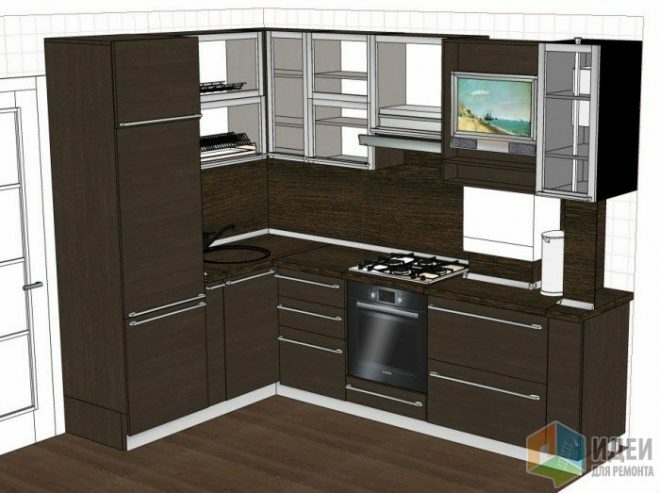
Attention! Earned on our website kitchen designer. You can familiarize yourself with it and design your dream kitchen for free! May also come in handy wardrobes designer.
The optimal location of the cutting table is between the stove and the refrigerator. The main principle of a modern kitchen is compactness, the ability to reduce unnecessary movements to a minimum. The corner kitchen provides all the possibilities for this.
Self-development of a kitchen project
First of all, you need to proceed from the specific dimensions of your own kitchen, taking into account: the dimensions of the room, the location of communications and ventilation, windows, ledges and niches, doorways.
First, a simple floor plan is created, indicating all dimensions and distances, on its basis a drawing of all cabinets will be drawn. Then you need to consider options for household appliances and devices, immediately calculating and proportioning them with the existing plan. Their dimensions must be determined not by eye, but after carefully reading the technical characteristics.
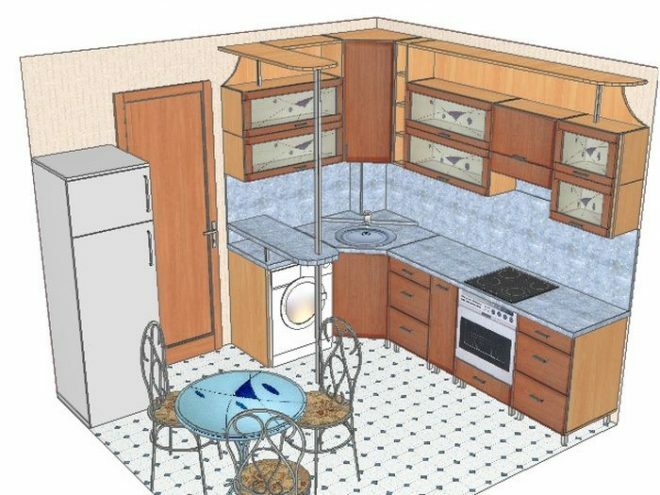
Then you need to calculate and select the important elements of the kitchen environment:
- countertops;
They can be of various lengths, thicknesses and widths, so it is important to immediately think about what dimensions it will be.
- lockers.
The dimensions of kitchen furniture in the drawings are on average the same. The upper, hinged ones - can be up to 90 cm high, the lower level - up to 90 mm. The standard depth is up to half a meter, while the table top should be 4–6 mm wider. Wall cabinets are shallower, usually 30–40 cm (this is only the usable volume, excluding the facade).
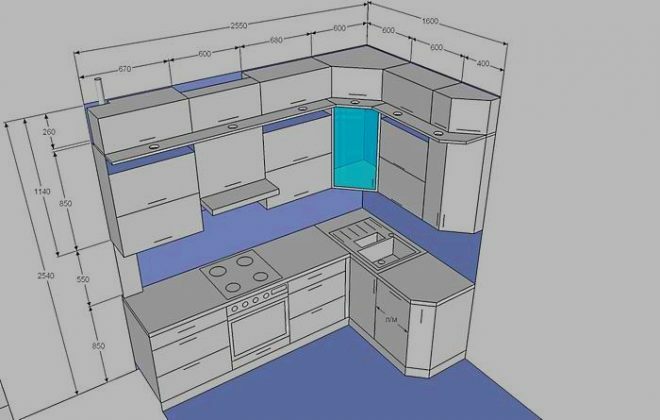
The width of the cabinets - upper and lower - is determined only based on the area of the room that will be allocated for them (30–100 cm). The lower corner cabinet is usually 80 to 90 cm wide. The upper corner cabinets for the corner are slightly narrower - up to 60 cm.
Having familiarized yourself with the basic standard dimensions of kitchen cabinets and drawings, after taking careful measurements, it is necessary to decide whether it is possible to dispense with the generally accepted dimensions of the elements or it will be necessary to make non-standard models.
Non-standard cabinets and bedside tables are also created if there are features of the room itself:
- niches;
- protrusions;
- the location of communications that does not allow you to enter standard options;
- electrical wiring - sockets to which there should be a free access;
- our own thoughtful project, which implies a non-standard approach to kitchen furnishing.
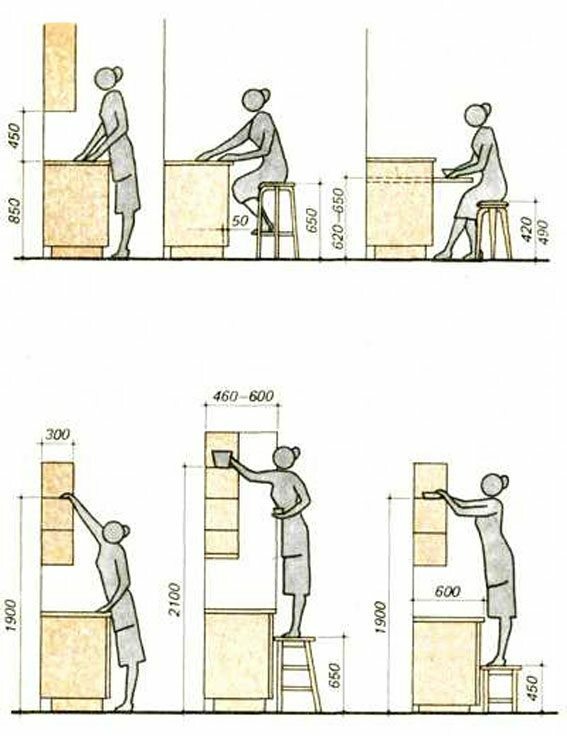
Protrusions and niches are leveled by playing with the depth of cabinets and cabinets - it increases or decreases. Cutouts are provided for the outlets, which will have to be accurately calculated even at the stage of creating a general plan.
If you are implementing your own project, you will have to create and calculate the dimensions of kitchen furniture, drawings - for each exclusive detail.

In general, the following sequence of actions should be followed:
- an accurate indication of all sockets, communications, pipes, as well as irregularities, protrusions and niches;
- arrangement of household appliances (with pedestals, they usually come in standard sizes);
- further in the drawing, all elements with standard dimensions should be entered;
- only in the last turn are the parts of the headset with special dimensions and unusual configuration calculated and "put in place".
As a basis, you can take a ready-made drawing with dimensions and detailing and change it in accordance with the dimensions of your kitchen.
How to create a drawing of corner kitchen furniture
You need to start drawing from the bottom tier - from the corner cabinet. Once you've created a starting point, you can continue to position the elements:
- household appliances (furniture in which it will be placed);
- standard pieces of furniture;
- non-standard additions.
All details in the drawing should be applied after accurate calculation, indicating all distances and dimensions - the kitchen drawing with dimensions must be error-free.
The initial element to be placed on the diagram is a corner cabinet. It can be either simple or trapezoidal. The corner element is most often used for a sink, on the right and left side tables are placed for utensils or for installing household appliances: a washing machine, dishwasher, oven. Such a module can be designed as a pentagon (trapezoidal, with an angle of 450). On the network you can find ready-made schemes with the dimensions of a corner kitchen and drawings, any option - it will only have to be adjusted to fit your ideas.
Sizing and detailing cabinets
To understand how to assemble a thing, you should "disassemble" it into its components. On the drawings of kitchen cabinets, all the details are visible, you can correctly calculate the size of the future product, as well as estimate the upcoming cutting costs.
According to the corner drawing with the dimensions of the kitchen, a cutting map is drawn up, which clearly demonstrates the consumption of material. In addition, accurate knowledge of the number and size of parts facilitates the task of subsequent assembly.
It is convenient to describe the detailing in the form of a table:
- all details are listed, including small ones;
- the number of each element is indicated;
- fit the dimensions calculated taking into account the characteristics of the room.
For instance:
Facade |
2 |
Table top |
1 |
Bottom |
1 |
A shelf |
2 |
Side wall |
2 |
Back wall |
1 |
Plank |
2 |
Legs |
4 |
The dimensions of each part fit into the same table - as accurately as possible, in millimeters. If there is a texture on the outside of the chipboard, you should also indicate its direction, so as not to forget about this when creating a kitchen cutting map.
All calculations are made taking into account the thickness of the sheet, so the type of material must be selected in advance in order to know its thickness. For example, the height of the base cabinet consists of the height of the vertical parts minus the thickness of the table top, the depth her - not only the width of the shelves, but also the thickness of the facade and a few millimeters on which the tabletop protrudes above body.
Examples of detailing of wall and floor cabinets and drawers
Detailing of the upper cabinets
For example, consider a corner cabinet without installing a dish drainer.
Corner cabinet components
side walls |
2 |
horizontal surfaces |
3 |
vertical bar |
1 |
The vertical bar is provided to give the structure the required rigidity. A recess is cut out in the middle horizontal shelf for it.
According to the same principle, the hood cabinet is detailed:
side walls |
2 |
horizontal shelves |
2 |
Holes are cut in the shelves along the diameter of the ventilation pipe - usually a corrugation with a diameter of 110 to 150 mm. The bottom shelf rises in accordance with the height of the ventilation unit itself.
Utensil cabinet
walls |
2 |
horizontal surfaces |
3 |
facades |
2 |
A horizontal facade (one or two) can be installed on such a cabinet - it will be opened using lifts.
By the same principle, you can detail any cabinets - with radius (rounded) shelves, with open and closed shelves.
Detailing of the lower pedestals is also not a problem - they are no more complicated than hinged ones. However, for the sink cabinet, the rear wall should be excluded, instead of it - the vertically located bar.
Corner version of the cabinet under the sink
bottom |
1 |
side walls |
2 |
corner vertical planks |
2 |
rear horizontal slats |
2 |
internal horizontal strips |
2 |
Such corner pedestals have a disadvantage - the difficulty in making full use of the space underneath. However, the problem is solvable - on sale there are designs specifically for corner furniture options that allow you to almost completely use the available volume. You can pick up models of corner boxes for the kitchen, the drawings and diagrams of which are available on the network and on relevant sites.
You can use ready-made drawings of kitchen cabinets with dimensions - adapt them to the dimensions of your project.
In addition to shelves, drawers can be planned. The only clarification: for their comfortable long-term use, it is better to purchase the appropriate fittings. Regardless of the number and weight of the items placed in them, they should slide out easily.
Such boxes can be installed as additional storage space, for example, under built-in appliances.
Detail of the drawer installed in the shelf
shelf bottom |
1 |
shelf cover |
1 |
side walls |
2 |
front and back wall of the drawer |
2 |
drawer side walls |
2 |
vertical planks |
2 |
The detailing shows that the box consists of 4 strips - two side, rear and front. The width (that is, the length of the back and front) is calculated as follows: the thickness of the two side ones is subtracted from the total width. The size of the bottom should be less than the dimensions of the box by 4 mm.
To slide the drawer out, you need guides, one on each side. Therefore, to calculate the width of the box from the width of the shelf space in which it will be installed, you need to subtract twice the sum of the thickness of the sidewall and the guide.
For the drawer to close tightly, the guide must be 5 mm shorter than the total depth of the cabinet or shelf (or more, but not less).
How to make all measurements correctly
It is necessary to take measurements accurately - the speed and quality of work in the future depends on it. The perimeter of the room is measured:
- on skirting boards;
- at the level of working surfaces (this is 85–95 cm);
- at the height of the average height of a person.
You will also have to check the height: take measurements in several places. This is how errors in this parameter are revealed.
All distances to pipes, sockets, windows are measured from one point (from the corner) - it should be taken as the starting point. The first stage of work on an independent project is a kitchen diagram with dimensions written in millimeters (for accuracy).
When calculating the dimensions of the kitchen environment or adapting the finished drawing to your needs, you should pay attention to the provided gap along the wall. It is left deliberately in case of an uneven wall. 5-7 cm of headroom helps to install furniture without significant rework.
If there is an unevenness, the margin allows you to slightly shift the items of the headset relative to each other, and then close the excess space along the wall with a special plinth.
When determining a place for household appliances, try to place them at a distance of at least 50 cm. The height must be calculated by adding the distance above the floor. Usually it is 10 cm, but if the floor is very even and durable (tiles, porcelain stoneware), and the set is planned from modern material (chipboard with MDF), then you can leave a smaller one - 6-7 cm.
If the headset is made of natural painted wood, then the distance should be greater - 12-15 cm. For parquet and wood painted floors, the distance should be even greater - 18–20 cm.
The distance from the ceiling must be at least 25 cm. If there is a ventilation hole in the wall, then the height of the headset should not exceed its underside. In addition, in the presence of ventilation, the room should be measured at this height.
If there is a gas riser, you should immediately take into account that the gas service employee should not have any obstacles or difficulties to access it - this will be the minimum used area.
Photo: diagrams and cutting of a corner kitchen with dimensions
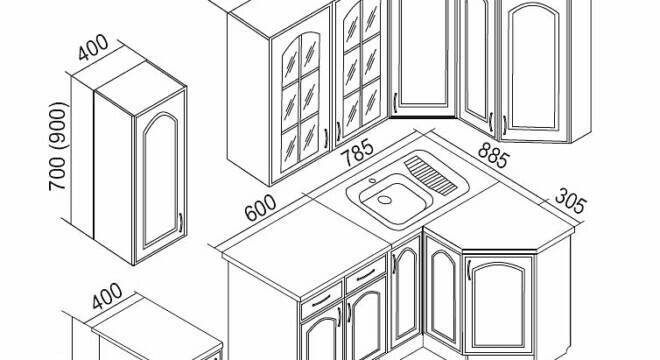
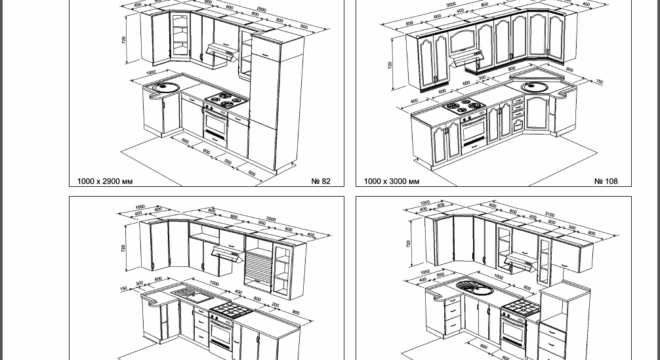
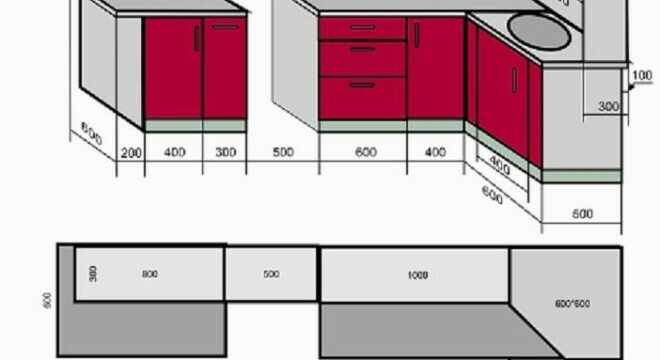
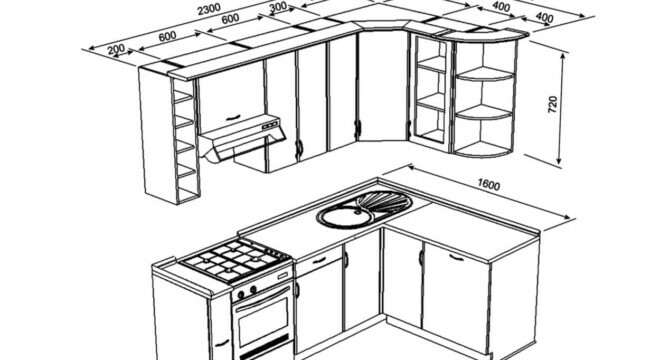
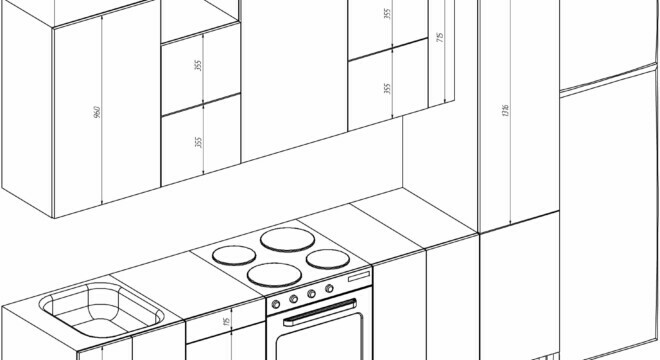
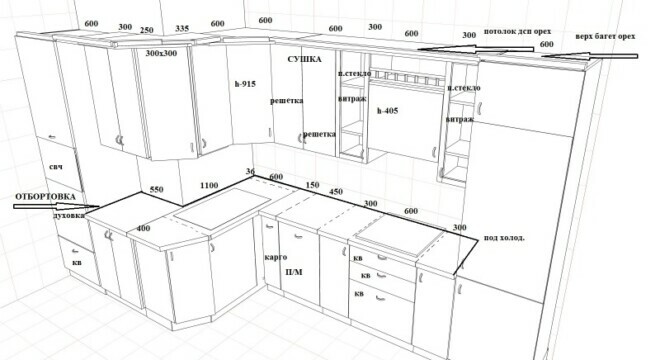
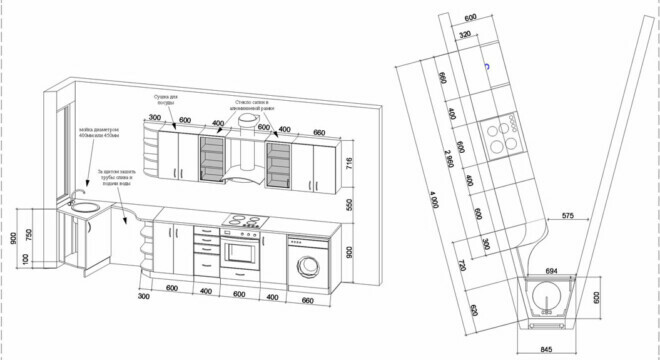
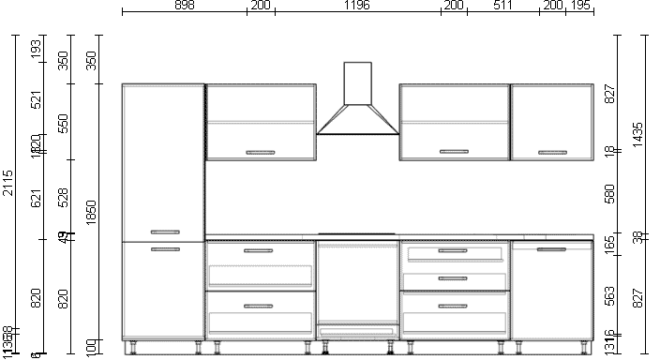
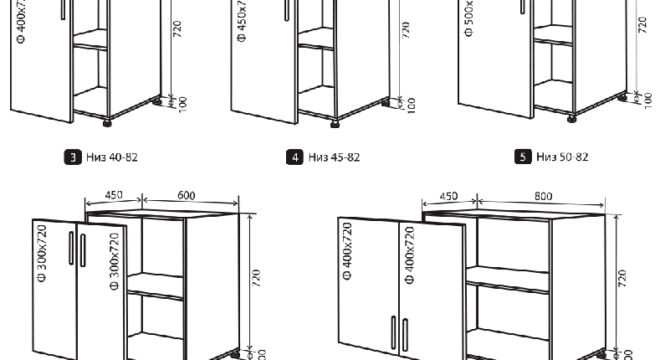
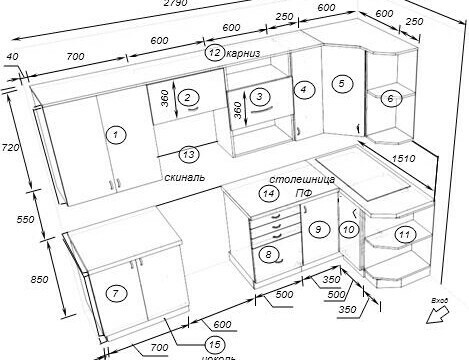
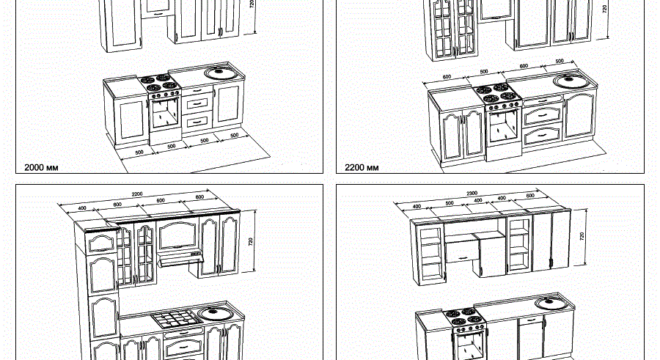
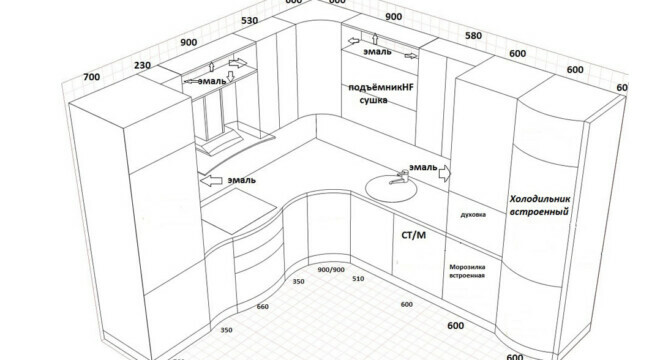
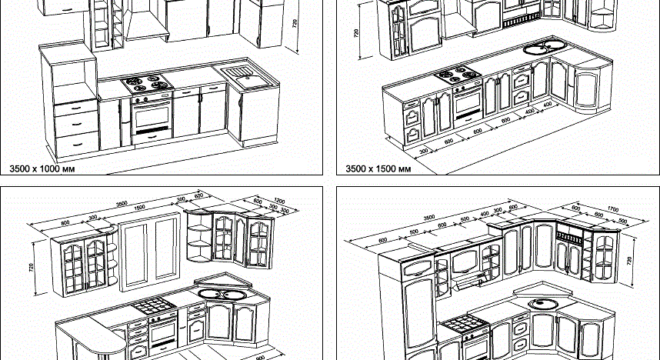
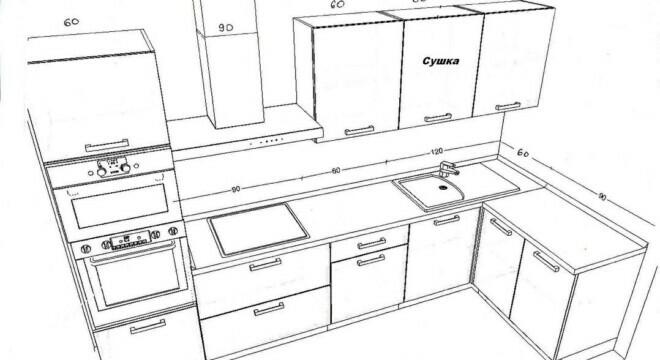
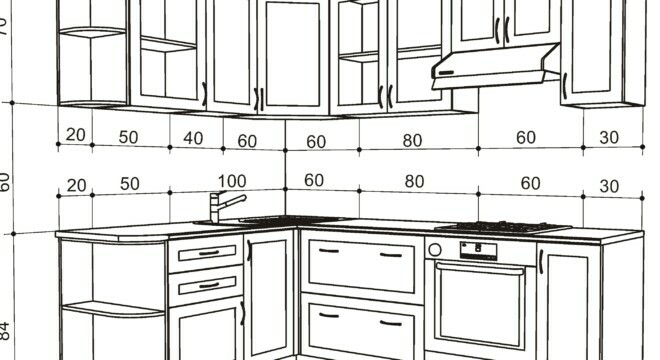
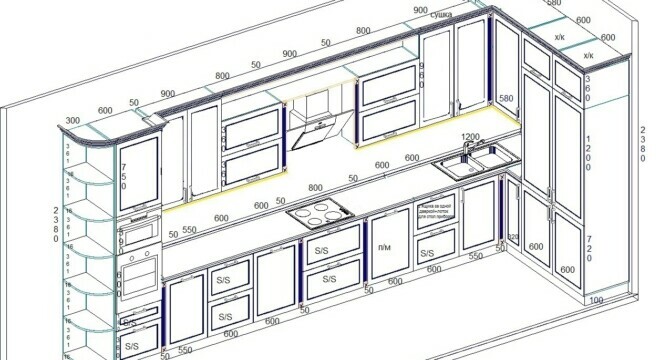
Prev
Next
There are undeniable advantages in independent design - first of all, it is a huge cost savings. With the effort and the right amount of time, you can create not only a functional, but also an aesthetic space for cooking and spending time with the whole family. The calculations may seem complicated at first, but numerous examples of beautiful and comfortable DIY kitchens will help solve the furnishing problem.
average rating 2.3 / 5. Number of ratings: 3
No ratings yet. Be the first to rate.


